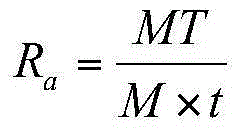Determination method of drought stress level of greenhouse crops
A technology for facility crops and drought stress, applied in the field of crop detection, to achieve high precision, accurate measurement, and relatively small error effects
- Summary
- Abstract
- Description
- Claims
- Application Information
AI Technical Summary
Problems solved by technology
Method used
Image
Examples
Embodiment 1
[0043] Step 1: Facility crop drought test
[0044] The crops in the seedling stage were transplanted into plastic pots. During the test, 4 water treatments were set. Normal irrigation T1 (70% to 80% of the maximum water holding capacity in the field) was the control group, and mild stress T2 (the maximum water holding capacity in the field 60% to 70% of the maximum field water capacity), moderate stress T3 (50% to 60% of the maximum field water capacity), severe stress T4 (field water capacity <50%), and three pots were set for each treatment.
[0045] The second step: equipment and medicine preparation
[0046] (1) Instruments and equipment
[0047] 10-1000μL, 1000-5000μL DRAGONLAB adjustable pipette gun, Shanghai Wandao Instrument Technology Co., Ltd.;
[0048] UV spectrophotometer, Shimadzu Corporation, Japan;
[0049] WP4-T dew point water potential meter, Beijing Ligaotai Technology Co., Ltd.;
[0050] Digital constant temperature water bath, Guohua Electric Co., Ltd....
Embodiment 2
[0096] According to the method of embodiment 1, utilize cauliflower to carry out drought test, set 4 water treatments, normal irrigation T 1 (70%-80% of the maximum water holding capacity in the field), as a control group, mild stress T 2 (60%-70% of the maximum water holding capacity in the field), moderate stress T 3 (50%-60% of the maximum water holding capacity in the field), severe stress T 4 (Field water capacity 1 was 48.5%, T2 was 32.4%, and T3 29.1%, T 4 was 21.6%. With the increase of the number of days after irrigation, the soil water content decreased slowly. On the third day after irrigation, the soil water content of each treatment tended to be stable and gradually approached. The soil water content of each treatment was: T 1 25.1%, T 2 21.0%, T 3 19.5%, t 4 During the test, the ambient temperature was 23°C / 17°C, the relative air humidity was 72%, and the photosynthetically active radiation was 800μmol·m -2 ·s -1 . Each treatment set up 3 pots to replica...
PUM
 Login to View More
Login to View More Abstract
Description
Claims
Application Information
 Login to View More
Login to View More - R&D
- Intellectual Property
- Life Sciences
- Materials
- Tech Scout
- Unparalleled Data Quality
- Higher Quality Content
- 60% Fewer Hallucinations
Browse by: Latest US Patents, China's latest patents, Technical Efficacy Thesaurus, Application Domain, Technology Topic, Popular Technical Reports.
© 2025 PatSnap. All rights reserved.Legal|Privacy policy|Modern Slavery Act Transparency Statement|Sitemap|About US| Contact US: help@patsnap.com



